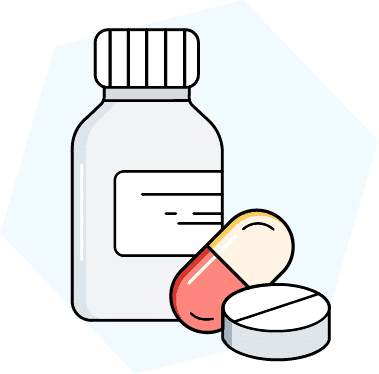Medigap does not cover prescription drugs. While benefits vary from policy to policy, Medigap will only help absorb Original Medicare Part A and Part B deductibles, coinsurance, and copayments.
For example, Medigap Plan C would pay your Part B copayment and deductible following a routine appointment with your primary care provider (PCP). However, if your PCP prescribed any medication for treatment, you would only receive financial assistance through supplementary Part D coverage or a Medicare Advantage Prescription Drug (MA-PD) policy. Medigap would offer no coverage.
Table of Contents
- Medigap Limitations on Prescription Drug Coverage
- How Medicare Part D Covers Prescription Drugs
- How Medicare Advantage Covers Prescription Drugs
- Alternate Coverage Options
- Should You Drop Medigap for Medicare Part D?
- How to Enroll in Medicare Part D
- Putting It All Together
- Frequently Asked Questions
Medigap Limitations on Prescription Drug Coverage
Some Medigap policies acquired before January 1, 2006, provided limited prescription drug benefits. However, following the creation of Medicare Part D through the Medicare Prescription Drug Improvement and Modernization Act of 2003 (MMA), private Medigap insurers no longer sell these prescription-inclusive plans. Therefore, all seniors who became Medicare-eligible after 2006 can only access pharmaceutical coverage through a Part D or an MA-PD plan.
Grandfathered Medigap Plans
If you have retained the same Medigap prescription drug policy since 2005 or earlier, Medicare may recognize it as a grandfathered health plan. Some grandfathered plans are still honored years or decades later, given the underlying contract details were made pre-MMA.
Because grandfathered health plans often hold different rights and protections than contemporary policies, beneficiaries should annually verify with their insurers whether their coverage still holds. Long-held Medigap prescription drug plans can lose grandfathered status anytime a policyholder authorizes significant coverage or payment adjustments. Similarly, individuals who unenroll and try to re-enroll later will find their original Medigap plan no longer exists.
How Medicare Part D Covers Prescription Drugs

Original Medicare beneficiaries who want prescription drug coverage must enroll in Medicare Part D. Unlike Part A and Part B, which offer relatively uniform benefits for all policyholders, private companies sell a wide array of Part D plans with varying premiums, drug formularies, and out-of-pocket costs.
Eligibility
Only Original Medicare members registered in both Part A and Part B can enroll in Medicare Part D. To avoid late registration penalties, you must purchase a Part D plan with Original Medicare during the Initial Enrollment Period (IEP) surrounding your 65th birthday.
Medicare Advantage beneficiaries cannot access Part D and must find comparable pharmaceutical coverage through an individual MA-PD policy.
Understanding Medicare Part D Formularies
Private companies sell Medicare Part D and have their own rules and structured “drug formularies.” If a prescribed medication does not fall under your formulary, you must settle for a generic alternative, switch plans, or pay the costs entirely out of pocket.
Part D plans must cover a wide array of medications commonly consumed by seniors, including those in “protected classes” like HIV/AIDS drugs. All Part D insurers rank these drugs under a tiered system to moderate costs. While these hierarchies vary, they typically resemble the following example:
- Tier 1: Most generic prescription drugs. Lowest copayment.
- Tier 2: Preferred, brand-name drugs. Medium copayment.
- Tier 3: Non-preferred, brand-name drugs. Higher copayment.
- Tier 4: High-cost specialty pharmaceuticals. Highest copayment.
How Medicare Part D Complements Medigap
Medigap and Part D often work together to minimize the out-of-pocket costs associated with Original Medicare.
Imagine your doctor prescribed a specific pain medication for a recent injury. After meeting your deductible, Medicare Part B would only pay 80% of your appointment costs and none of your pharmaceutical expenses. Meanwhile, 8 of 10 Medigap plans would absorb this deductible and the remaining 20% coinsurance in full. Part D would partially cover the prescribed pain medication or any viable generic alternative.
Together, Medical and Medicare Part D provide significantly more coverage than Original Medicare does alone.
How Medicare Advantage Covers Prescription Drugs
Private companies approved by Medicare can sell Medicare Advantage – or Medicare Part C – Plans according to flexible pricing and coverage protocols. While these policies must legally offer equivalent benefits to Original Medicare, many cover supplementary services like dental care, eye exams, gym memberships, and prescription drugs for little to no extra cost.
In 2023, 97% of all Medicare Advantage enrollees had access to prescription drug benefits through their primary plan. Notably, over 70% of these individuals paid no additional premium for this expanded coverage.
To join an MA-PD, Medicare-eligible seniors must do so during the following enrollment periods:
- Your Individual Enrollment Period (IEP)
- The Annual Enrollment Period (AEP) between October 15 and December 7
- The Medicare Advantage Open Enrollment Period between January 1 and March 31
Comparing Medicare Advantage with Medicare Part D
While MA-PDs and standalone Medicare Part D plans (PDPs) offer comparable prescription drug benefits, each presents unique advantages and disadvantages.
For example, MA-PD enrollees can often access additional covered services like gym memberships, dental care, and grocery allowances for little to no extra cost. Furthermore, MA-PDs typically charge lower premiums, deductibles, and copayments.
However, unlike widely accepted Original Medicare coverage, Medicare Advantage insurers can impose stringent medical networks and require preauthorization. Therefore, a combined Original Medicare and Part D health insurance package may better suit individuals who want access to a broad network and already have supplementary dental or vision benefits through alternative sources.
Alternate Coverage Options

Considering the limited prescription drug coverage provided by Part A and B alone, seniors with pharmaceutical needs must purchase supplementary benefits. If you cannot afford an MA-PD or standalone Part D policy, explore the following alternatives:
- Employer-sponsored healthcare: Non-retired seniors may delay Medicare enrollment and remain on their company’s prescription drug plan.
- Employer or union retiree plans: Some large businesses and labor unions offer members extended health coverage and prescription drug benefits after they retire.
- Medicaid: Seniors with dual eligibility for Medicare and Medicaid can access Medicaid prescription drug coverage in all 50 states.
- Programs of All-Inclusive Care for the Elderly (PACE): Some seniors with Medicaid and Medicare can also enroll in PACE, which covers all prescription and non-prescription drugs.
Should You Drop Medigap for Medicare Part D?
Medicare Part D financially penalizes eligible seniors who delay enrollment beyond their IEP. However, people with creditable drug coverage through their employer, Medicaid, or a grandfathered Medigap plan can typically bypass these charges, given their existing benefits continue to meet Medicare’s standards of care.
While remaining on a grandfathered Medigap prescription drug plan may temporarily save you money, you will likely eventually have to purchase a standalone Part D plan whenever Medicare deems your existing pharmaceutical coverage as non-creditable. People who lose creditable drug benefits have 63 days to secure a replacement Part D plan before incurring penalties.
How to Enroll in Medicare Part D
If your grandfathered Medigap plan loses creditability, follow these steps to secure Medicare Part D:
- Verify your eligibility. Only Original Medicare members with Part A and Part B can purchase supplementary Part D coverage.
- Compare your options. Use Medicare’s online plan finder tool to search for policies with favorable drug formularies and cost-sharing protocols.
- Plan around enrollment windows. If you miss the IEP surrounding your 65th birthday, you can still secure Part D during the AEP between October 15 and December 7.
- Purchase coverage. Fill out an application and pay your first premium to activate your new pharmaceutical benefits.
People interested in MA-PD plans can also follow these instructions but must drop their Original Medicare coverage before switching policies.
Understanding Medicare Part D Penalties

While securing a Medicare Part D plan will ultimately save you money on prescription drugs, waiting until after your IEP could result in long-term late enrollment penalties. Medicare calculates these charges by multiplying 1% of the “national base beneficiary premium” ($34.70 in 2024) by the combined months you did not have Part D or another creditable form of drug coverage.
For example, if you waited 29 months after your IEP to enroll in Part D, your penalty would equal 29% (1% for each month delayed) of $34.70 (the national base premium in 2024). You would have to pay this recurring sum of $10.10 in addition to your new Part D plan’s monthly premium for as long as you retain coverage.
Putting It All Together
Since the implementation of Medicare Part D, Medigap insurers have ceased offering plans with built-in medication benefits. Furthermore, Medicare has stopped recognizing many of these grandfathered Medigap policies as creditable drug coverage. Therefore, Medicare beneficiaries who want pharmaceutical benefits should switch to Medicare Advantage or purchase a standalone Part D plan.
Before settling on a final policy, compare various drug formularies, premium rates, and cost-sharing protocols to find coverage that fits your unique needs. If you have questions about enrollment windows or potential late penalties, call 1-800-MEDICARE for expert guidance from a licensed professional.
